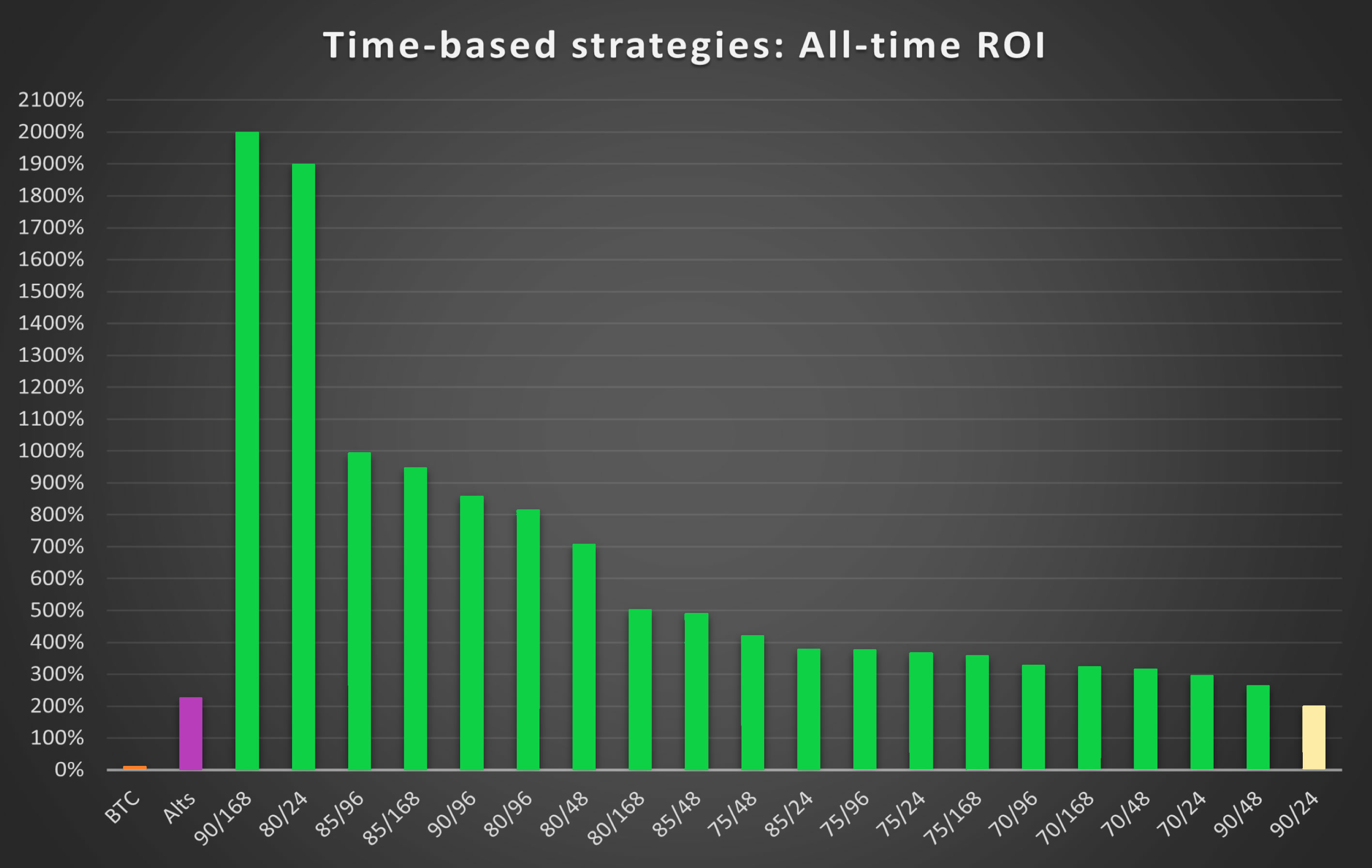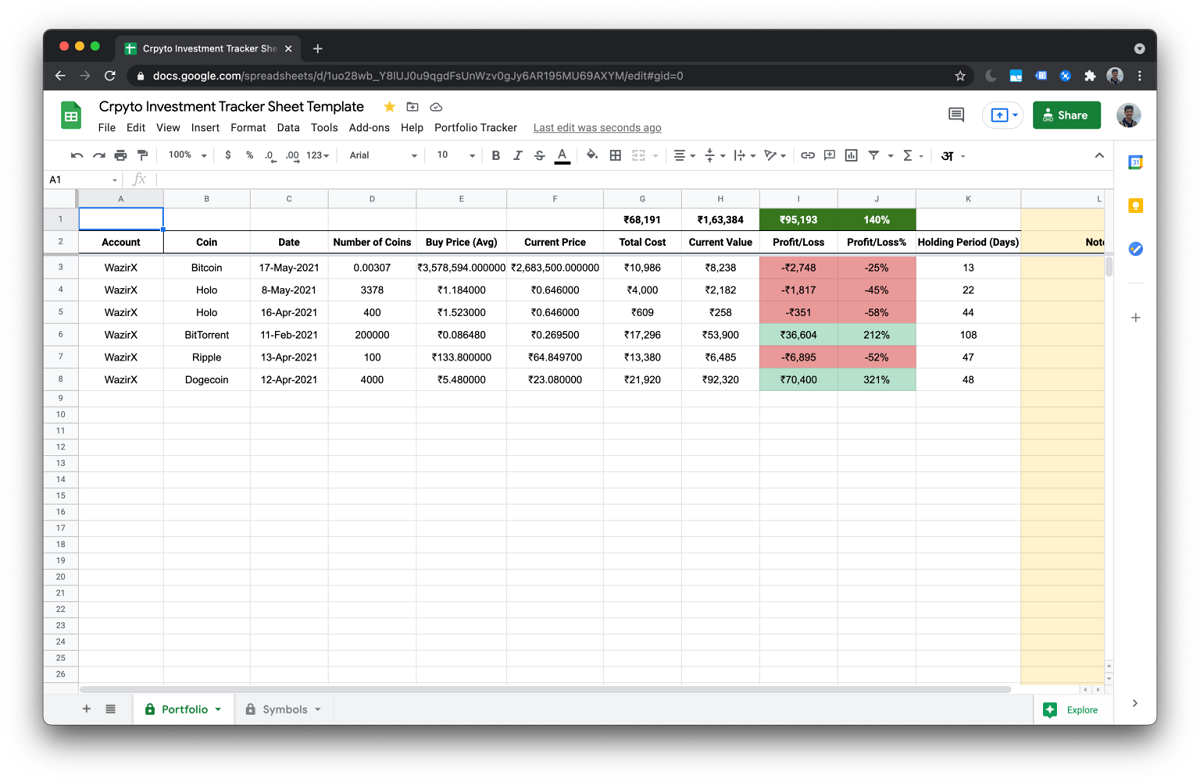Introduction
Welcome to the exciting world of cryptocurrency! As the popularity of digital currencies continues to rise, more and more people are exploring the potential investment opportunities they offer. One crucial aspect of crypto investing is understanding the concept of Return on Investment, or ROI.
ROI is a financial indicator that measures the profitability of an investment relative to its cost. It allows investors to gauge the efficiency of their investment by determining the returns they can expect for every dollar invested. In the context of cryptocurrencies, ROI is a valuable metric that helps investors evaluate the success of their crypto ventures.
Why is ROI important in the world of crypto? Well, the volatile and ever-changing nature of the cryptocurrency market requires investors to make informed decisions. By calculating and analyzing ROI, investors can assess the potential gains and risks associated with different crypto investments. This information empowers them to make well-informed decisions and allocate their resources wisely.
Calculating ROI in the world of cryptocurrencies can be a complex task. The value of digital assets can fluctuate significantly in short periods, leading to potential gains or losses. It becomes crucial for investors to understand the factors that affect ROI and implement effective strategies to maximize their returns.
This article will delve into the world of ROI in crypto investing. We will explore the process of calculating ROI, discuss the factors that influence ROI in the volatile crypto market, and provide actionable strategies to maximize ROI. Additionally, we will highlight the risks and limitations of relying solely on ROI as a measure of success in the crypto space.
So, buckle up and join us on this journey to unravel the secrets of ROI in crypto investing!
What is ROI?
Return on Investment (ROI) is a financial metric used to assess the profitability and success of an investment. It measures the ratio of the net profit or gain from an investment to the initial investment cost, expressed as a percentage. In simple terms, ROI answers the question: “How much am I getting back for every dollar I invest?”
ROI allows investors to evaluate the efficiency and performance of their investments by comparing the returns generated to the amount of capital invested. A higher ROI indicates a more profitable investment, while a lower ROI suggests a less successful one.
In the context of cryptocurrency investments, ROI is an essential measure to determine the profitability of investing in various digital assets. As the crypto market is highly volatile and dynamic, calculating and tracking ROI helps investors gauge the success of their ventures and make informed decisions.
The formula to calculate ROI can be expressed as:
ROI = (Net Profit / Initial Investment Cost) x 100
For example, if you invested $1,000 in a cryptocurrency and sold it later for $1,500, your net profit would be $500. Using the formula mentioned above, the ROI would be:
ROI = ($500 / $1,000) x 100 = 50%
This means that for every dollar invested, you gained 50 cents in profit.
ROI is a versatile metric that can be applied to both short-term and long-term investments. In the world of cryptocurrencies, where market conditions can change rapidly, it is essential to calculate ROI regularly to track the performance and adjust investment strategies accordingly.
While ROI is a valuable measurement tool, it is crucial to consider other factors such as timeframes, potential risks, and market trends when making investment decisions. ROI alone does not provide a comprehensive picture of an investment’s success, as it does not consider additional costs, ongoing expenses, or potential fluctuations in the market.
Now that we have a better understanding of what ROI is let’s explore why it is particularly important in the realm of crypto investing.
Why is ROI important in crypto?
ROI holds significant importance in the world of cryptocurrency due to the unique characteristics and volatility of the crypto market. Understanding the role of ROI in crypto investing can help investors make informed decisions and navigate the complex landscape more effectively.
1. Evaluating Profitability: ROI allows investors to assess the profitability of their crypto investments. By calculating ROI, investors can understand how much return they are generating for every dollar invested. This knowledge helps in identifying successful investments and optimizing future investment decisions.
2. Comparing Investment Options: The crypto market offers a wide range of investment opportunities, each with varying potential returns. Calculating ROI allows investors to compare and evaluate different cryptocurrencies and investment strategies. This helps in identifying which investments have the potential to deliver the highest returns on investment.
3. Managing Risk: Cryptocurrencies are notorious for their volatility. ROI helps investors assess the risk associated with their investments by providing insights into potential gains or losses. By understanding the potential ROI, investors can assess if the potential rewards outweigh the risks involved.
4. Tracking Performance: Calculating ROI on a regular basis allows investors to track the performance of their crypto investments over time. This helps in identifying trends, understanding the impact of market fluctuations, and making necessary adjustments to investment strategies.
5. Making Informed Decisions: ROI provides a quantitative metric that helps investors make well-informed and objective decisions. By analyzing the ROI, investors can determine if an investment aligns with their financial goals and risk tolerance. This helps in avoiding impulsive decisions and minimizing the potential for losses.
6. Allocating Resources Wisely: ROI enables investors to allocate their financial resources more effectively. By comparing the potential ROI of different investment options, investors can allocate their capital to investments that offer the highest potential returns. This helps in optimizing the use of resources and maximizing overall portfolio performance.
Overall, ROI plays a crucial role in the crypto space by helping investors assess the profitability, manage risk, and make informed investment decisions. However, it’s important to remember that ROI is just one metric among many. Investors should consider other factors such as market trends, industry analysis, and their own risk tolerance when making investment decisions in the volatile crypto market.
How to Calculate ROI in Crypto
Calculating ROI in the world of cryptocurrencies may seem daunting at first, but it can be broken down into a straightforward formula. Here’s a step-by-step guide to help you calculate the ROI of your crypto investments:
1. Determine Initial Investment: Begin by identifying the total amount of money you initially invested in a specific cryptocurrency. This includes the purchase price of the digital assets and any associated transaction fees.
2. Determine Final Value: Next, determine the current value of your cryptocurrency holding. This can be done by multiplying the current price of the cryptocurrency by the number of coins or tokens you hold.
3. Calculate Net Profit: Subtract the initial investment cost from the final value to determine the net profit. This represents the total gains or losses generated from your investment.
4. Apply the ROI Formula: Use the formula below to calculate the ROI percentage.
ROI = (Net Profit / Initial Investment) x 100
For example, if you invested $10,000 in a cryptocurrency and sold it later for $15,000, your net profit would be $5,000. Applying the ROI formula:
ROI = ($5,000 / $10,000) x 100 = 50%
This means that you have gained 50% on your initial investment.
It is essential to note that calculating ROI accurately requires considering any additional costs involved, such as transaction fees, trading fees, and taxes. These costs may affect the overall ROI percentage, so be sure to include them in your calculations.
To track the performance of your crypto investments over time, it is recommended to calculate ROI regularly, such as weekly, monthly, or annually. This will help you to monitor the success of your investments and make informed decisions based on updated data.
Several online tools and cryptocurrency portfolio trackers offer automated ROI calculations, making it easier to track the performance of your crypto investments. Utilizing these tools can save time and provide accurate calculations of ROI for multiple crypto assets.
Now that you understand how to calculate ROI in crypto, let’s explore the factors that can influence ROI in the volatile crypto market.
Factors that Affect ROI in Crypto
Return on Investment (ROI) in the cryptocurrency market is influenced by various factors that can impact the profitability of your investments. Understanding these factors is crucial for making informed decisions and managing risk. Here are some key factors that can affect ROI in the volatile world of crypto:
1. Market Volatility: The cryptocurrency market is known for its high volatility, with prices fluctuating rapidly. Sudden price movements can significantly impact the ROI of your investments. While volatility presents opportunities for substantial gains, it also brings the risk of significant losses. It’s essential to consider market volatility when calculating ROI and setting realistic expectations.
2. Market Demand and Adoption: The demand for a particular cryptocurrency can influence its price and overall ROI. Factors such as increased adoption, partnerships with major companies, and regulatory changes can positively impact the demand for a cryptocurrency, potentially driving up its ROI. Stay informed about the market trends and the adoption of cryptocurrencies to identify potential opportunities.
3. Technology and Development: The technological advancements and developments surrounding a cryptocurrency can significantly affect its ROI. Upgrades, innovations, and improvements in security, scalability, and utility can make a cryptocurrency more attractive to investors and users. Understanding the technological aspects of a cryptocurrency can help you assess its long-term potential for ROI.
4. Project Fundamentals: Assessing the fundamentals of a cryptocurrency project is vital in determining its ROI potential. Factors like the team’s experience, project roadmap, partnerships, and community support play a role in the success and overall ROI of a cryptocurrency. Thoroughly research the project and its fundamentals before investing to increase your chances of achieving a favorable ROI.
5. Regulatory Environment: Cryptocurrencies operate within a regulatory landscape that can impact their ROI. Regulatory changes or announcements can cause significant price fluctuations and affect the overall market sentiment. Stay updated on regulatory developments and their potential impact on cryptocurrencies to make informed investment decisions.
6. Investor Sentiment and Market Psychology: Cryptocurrency markets are influenced by investor sentiment and market psychology. Fear, uncertainty, and greed can drive prices up or down, impacting the ROI of investments. It’s crucial to be aware of market sentiment and avoid making impulsive decisions based solely on emotions.
Remember that these factors are interconnected and can influence each other. Analyzing them in conjunction with your investment goals and risk tolerance can help you make informed decisions and maximize your ROI potential in the crypto market.
Now that we have discussed the factors that affect ROI in crypto, let’s explore some strategies to maximize your ROI in the volatile world of cryptocurrency.
Strategies to Maximize ROI in Crypto
Maximizing your Return on Investment (ROI) in the cryptocurrency market requires careful planning, analysis, and strategic decision-making. Here are some effective strategies to help you maximize your ROI in the volatile world of crypto:
1. Conduct Thorough Research: Before investing in any cryptocurrency, conduct in-depth research about the project, its team, and its underlying technology. Understand the market potential, competition, and any potential risks involved. Make informed decisions based on a solid understanding of the fundamentals.
2. Diversify Your Portfolio: Diversification is crucial to manage risk and potentially increase ROI. Instead of putting all your funds into a single cryptocurrency, consider diversifying your portfolio across different cryptocurrencies and asset types. This spreads the risk and allows you to benefit from multiple investment opportunities.
3. Set Realistic and Achievable Goals: Define your investment goals and set realistic expectations. Understand that the cryptocurrency market is highly volatile and can experience significant ups and downs. Establish achievable goals based on thorough analysis and market trends.
4. Stay Informed: Stay up-to-date with the latest news, market trends, and regulatory changes in the cryptocurrency space. Follow reliable sources, join online communities, and engage in discussions to gain valuable insights. Being informed allows you to react quickly to market shifts and make well-timed investment decisions.
5. Use Stop Loss and Take Profit Orders: Implementing stop loss and take profit orders can help minimize losses and secure profits. Set predetermined price levels to automatically sell a cryptocurrency if it reaches a certain price point, protecting your investment from significant downturns and cashing in on profitable positions.
6. Follow a Long-Term Investment Approach: Cryptocurrency markets can be highly volatile in the short term. Consider adopting a long-term investment approach to maximize potential ROI. Look for cryptocurrencies with strong fundamentals, promising technology, and long-term growth potential.
7. Use Dollar-Cost Averaging (DCA): DCA is a strategy where you invest a fixed amount of money at regular intervals, regardless of the cryptocurrency’s price. This approach allows you to mitigate the impact of price volatility by buying more when prices are low and less when prices are high. DCA can help you accumulate more assets over time and potentially enhance your ROI.
8. Utilize Technical and Fundamental Analysis: Use technical analysis tools and indicators to identify price patterns, trends, and potential entry and exit points. Combine this with fundamental analysis, considering the project’s development, partnerships, and news events. Combining these analyses can improve your decision-making process and help maximize ROI.
9. Consider Staking and Yield Farming: Explore staking or yield farming opportunities offered by certain cryptocurrencies. These strategies involve locking your assets in protocols to earn rewards or yield on your investment. Staking and yield farming can provide an additional source of income and potentially boost your overall ROI.
10. Continuously Evaluate and Adjust: Regularly review your investment performance and adjust your strategy accordingly. Be open to learning from your experiences, adapting to market conditions, and reallocating your resources based on changing trends.
By implementing these strategies and continuously refining your approach, you can aim to maximize your ROI in the dynamic and ever-evolving world of cryptocurrencies.
Risks and Limitations of Using ROI in Crypto Investing
While Return on Investment (ROI) is a valuable metric in assessing the profitability of crypto investments, it is important to be aware of the risks and limitations associated with relying solely on ROI in the crypto space. Understanding these risks and limitations can help you make more informed investment decisions. Here are some key points to consider:
1. Volatility and Market Risk: Cryptocurrencies are highly volatile assets, and their prices can experience rapid and significant fluctuations. ROI calculations may not capture the full extent of market risk and the potential for sudden price movements. Investing in crypto carries inherent market risks that can impact your ROI significantly.
2. Lack of Regulation and Transparency: The crypto market operates with less regulation and oversight compared to traditional financial markets. This lack of regulation can result in limited transparency and increased risk of fraud or market manipulation. The absence of comprehensive reporting standards can make it challenging to accurately calculate ROI and assess the true value of investments.
3. Limited Historical Data: The relative novelty of cryptocurrencies means that historical data is limited compared to more mature financial markets. This scarcity of historical data can make it challenging to accurately predict future price movements and estimate ROI. It is important to consider other factors alongside ROI calculations when evaluating investments.
4. Technical and Security Risks: Investing in cryptocurrencies involves technical risks, such as vulnerabilities in blockchain technology or the potential for hacking and cybersecurity breaches. Security incidents can impact the value of your investments and affect your ROI. Understanding and managing these risks is crucial for safeguarding your assets.
5. Human Error and Behavioral Biases: Investing in crypto is subject to human error and behavioral biases, such as fear of missing out (FOMO) or panic selling during market downturns. These emotional factors can lead to impulsive decision-making that may not align with rational ROI calculations. It is important to maintain a disciplined investment approach and account for potential bias.
6. Liquidity Risk: Some cryptocurrencies may have lower liquidity, meaning there may be limited buyers or sellers in the market. This can impact your ability to buy or sell at desired prices, potentially affecting ROI. Illiquid markets may also be prone to price manipulation or increased volatility.
7. Timing and Entry Points: The timing of your entry into the crypto market can significantly impact ROI. Entering at a peak or selling at a low point can diminish potential returns. It can be challenging to accurately time market movements, making it crucial to consider long-term goals and strategies when investing in cryptocurrencies.
8. External Factors: ROI calculations may not fully account for external factors that can impact the crypto market, such as economic conditions, regulatory developments, or geopolitical events. These factors can influence investor sentiment and market dynamics, affecting the overall ROI of investments.
It is important to note that ROI should be used as one tool among many when evaluating crypto investments. It provides a quantitative measure but does not capture the full complexity and nuances of the market. Assessing broader factors such as project fundamentals, technology, market trends, and risk management strategies alongside ROI calculations can lead to more informed investment decisions.
Now that we have explored the risks and limitations of relying solely on ROI, let’s summarize the key takeaways from this article.
Conclusion
Cryptocurrency investing can be a rewarding but complex endeavor, and calculating Return on Investment (ROI) is a crucial tool in evaluating the profitability of your investments. By understanding and applying ROI calculations, investors can gauge the efficiency and success of their crypto ventures.
Throughout this article, we have explored the concept of ROI in the world of cryptocurrencies. We learned that ROI measures the profitability of an investment relative to its cost and provides valuable insights into potential gains and risks associated with different crypto investments.
ROI is important in the crypto space because it helps investors evaluate profitability, compare investment options, manage risks, track performance, make informed decisions, and allocate resources wisely. However, it is important to consider ROI alongside other factors such as market volatility, project fundamentals, market demand, and regulatory changes.
We also discussed how to calculate ROI in crypto, highlighting the steps involved in determining initial investment, final value, net profit, and applying the ROI formula. Regularly calculating ROI and utilizing online tools and portfolio trackers can help investors stay informed and track the performance of their crypto investments.
Moreover, we explored the factors that can affect ROI in the volatile crypto market, such as market volatility, market demand and adoption, technology and development, project fundamentals, regulatory environment, and investor sentiment. Understanding these factors allows investors to make more informed decisions and navigate the crypto market effectively.
To maximize ROI in crypto, we provided strategies such as conducting thorough research, diversifying your portfolio, setting realistic goals, staying informed, utilizing stop loss and take profit orders, following a long-term investment approach, practicing dollar-cost averaging, utilizing technical and fundamental analysis, and exploring staking and yield farming opportunities.
Lastly, we discussed the risks and limitations of relying solely on ROI in crypto investing. Factors such as market volatility, lack of regulation, limited historical data, technical and security risks, human error and biases, liquidity risk, timing and entry points, and external factors can impact the accuracy and reliability of ROI calculations.
In conclusion, ROI is a valuable metric in the world of crypto investing, but it should not be the sole factor in decision-making. It is crucial to consider a holistic approach, assessing multiple factors, staying informed, and maintaining a long-term perspective to navigate the crypto market successfully and potentially achieve favorable ROI.

























